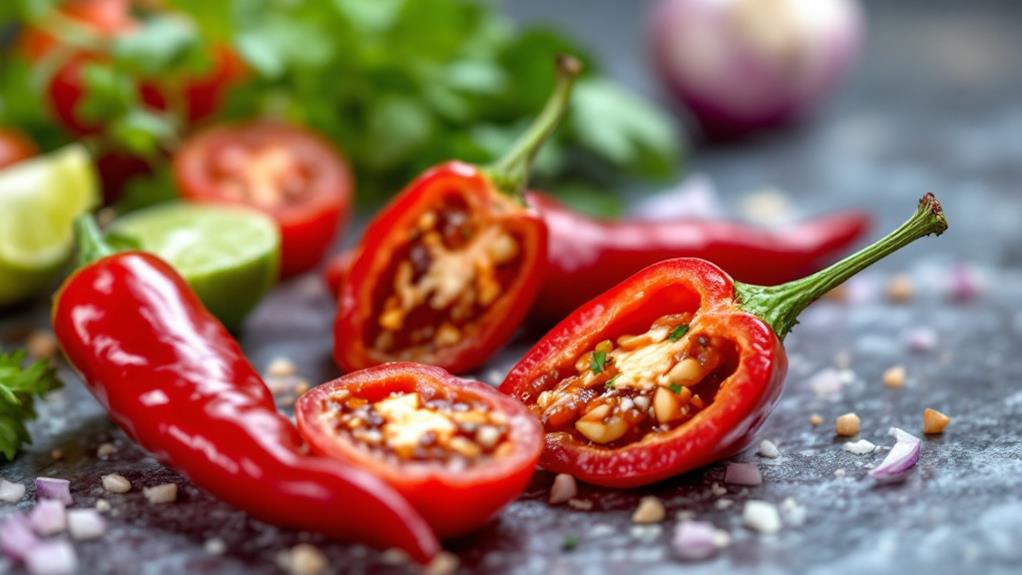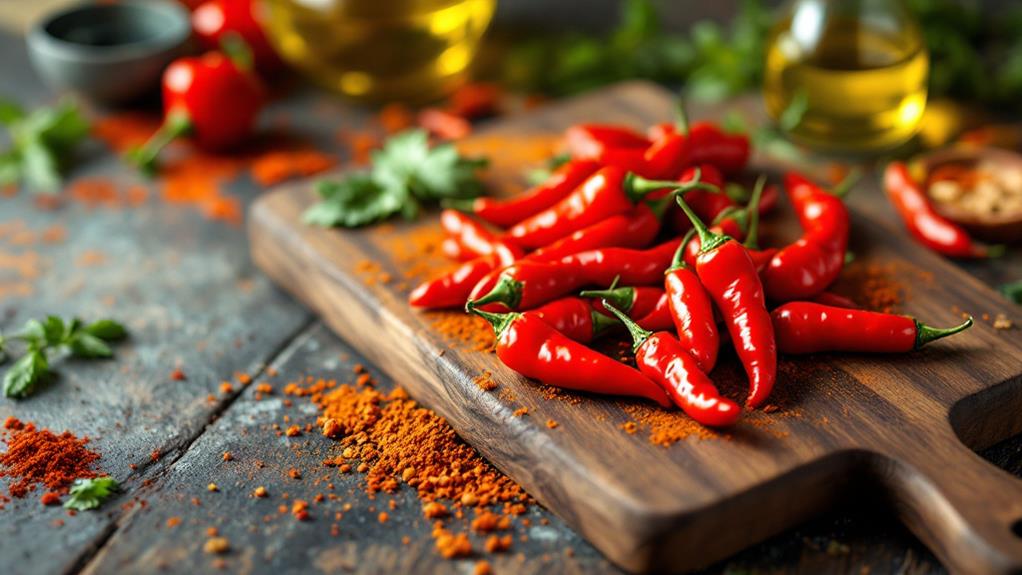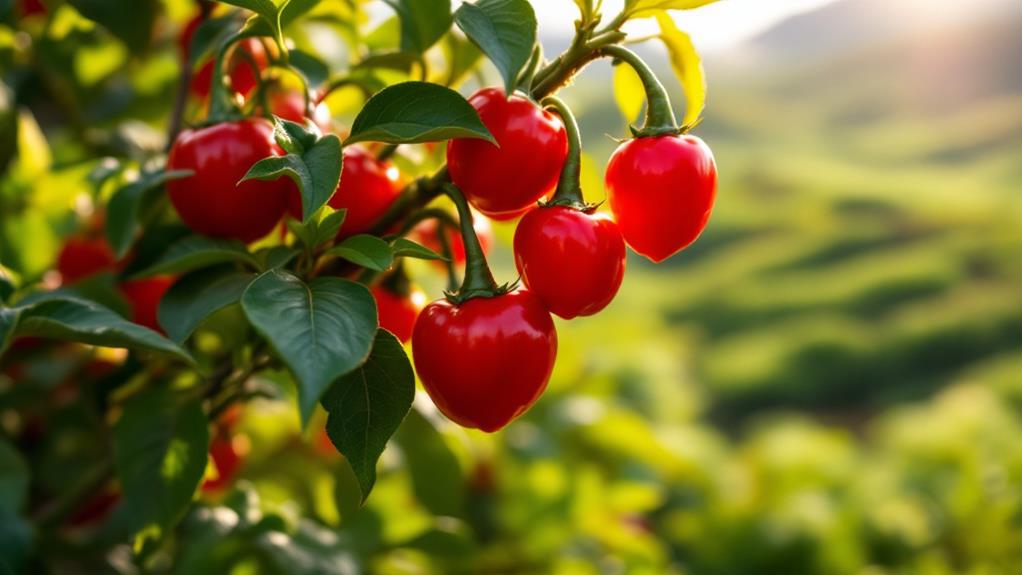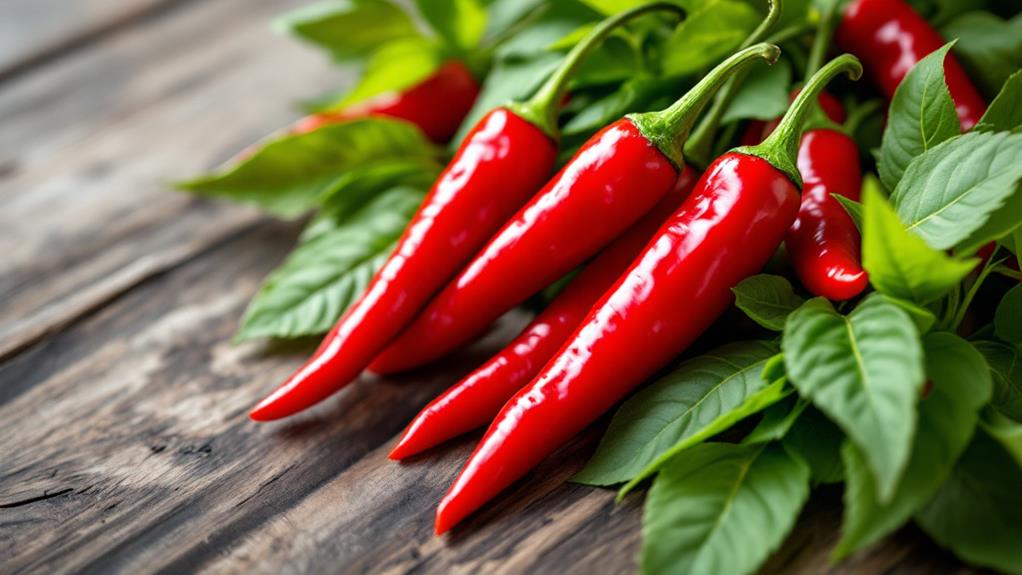Discover the Peri-Peri Pepper: Heat, Flavor, and Recipes
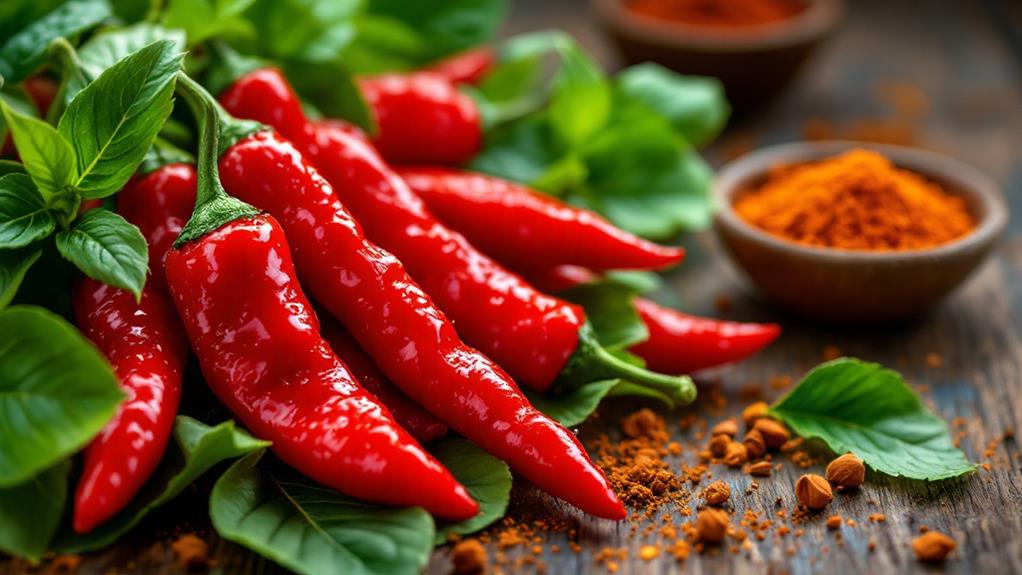
Uncover the fiery Peri-Peri pepper, known for its heat ranging from 50,000 to 175,000 Scoville Heat Units. It delivers an intense kick quickly followed by a subtle fruity finish. This African Birds Eye chili is incredibly versatile, perfect in marinades, sauces, and spice blends. Rich in vitamins and minerals, it enhances metabolism and offers anti-inflammatory benefits. Popular in dishes like Peri-Peri chicken and shrimp, it brings a spicy twist to your meals. Experiment with making Peri-Peri sauce at home for a fresh, zesty kick. Let's plunge deeper into its cultural roots and culinary possibilities.
Peri-Peri Pepper Overview
The Peri-Peri pepper's fiery reputation stems from its impressive heat range of 50,000 to 175,000 Scoville Heat Units, making it much hotter than jalapeños. Known also as the African Birds Eye chili, this pepper is native to Southeastern Africa and has been cultivated for centuries. Its name comes from the Swahili word "pili-pili," meaning chili. With a heat profile that develops quickly and fades rapidly, Peri-Peri peppers are beloved by chili enthusiasts.
In the kitchen, Peri-Peri peppers shine due to their versatility in culinary applications. You can use them in marinades to impart a bold flavor to meats or in sauces to add a spicy kick to your favorite dishes. These chili peppers are also a popular choice for spice blends, enhancing the complete flavor profile of many recipes. Besides their culinary appeal, Peri-Peri peppers offer health benefits. They are rich in vitamins and minerals and contain capsaicin, which is known for its anti-inflammatory properties and potential to enhance metabolism.
Whether you're experimenting with a new marinade or seeking health benefits, the Peri-Peri pepper brings both heat and flavor to your table.
Heat Level of Peri-Peri
When you bite into a Peri-Peri pepper, you're met with an intense heat that quickly grabs your attention. This pepper, ranking between 50,000 to 175,000 Scoville Heat Units (SHU), is considerably hotter than jalapeños. The heat profile of Peri-Peri peppers develops rapidly, offering a fiery experience for chili enthusiasts, yet it subsides just as quickly, leaving behind its complex, fruity flavors. These flavors add to its culinary appeal, making it a popular choice for those who appreciate a blend of heat and taste.
Different factors, like growing conditions and preparation methods, influence the Peri-Peri's heat intensity. While it's hotter than Thai chili and cayenne, it remains milder than extreme varieties such as the Carolina Reaper or Pepper X. This balance makes it versatile in the kitchen, allowing you to investigate a heat level that's not overwhelming but still packs a punch.
Whether you're aiming for something mild or looking to push your heat tolerance, the Peri-Peri pepper offers a unique experience. Its ability to be both intensely hot yet quickly cooling makes it a fascinating ingredient to examine in your culinary adventures.
Cultural Origins
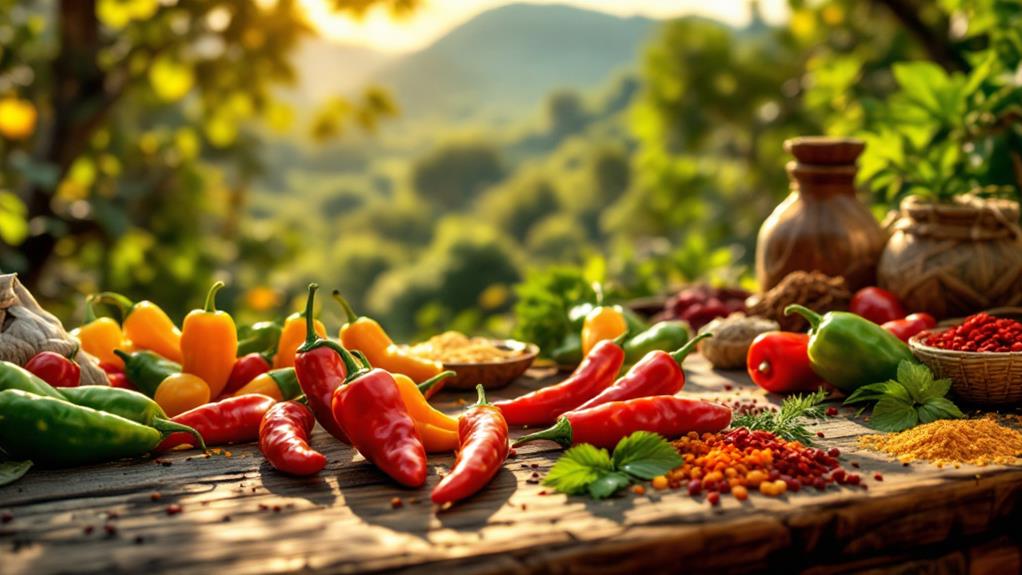
Exploring the heat of the Peri-Peri pepper leads us to its rich cultural origins, deeply rooted in Southeastern Africa. The peri-peri pepper, also known as African Birds Eye, is a staple of the region, cultivated for centuries and celebrated for its unique heat and flavor. The Swahili word "pili pili" gives this fiery chili its name, highlighting its African roots and cultural significance.
The story of the peri-peri pepper took a fascinating turn during the 15th century when Portuguese settlers arrived in Mozambique. They encountered this fiery gem and incorporated it into their culinary traditions, creating a fusion of African and Portuguese flavors that's still enjoyed today. The pepper's influence didn't stop there; it's now a globally cultivated crop, thriving in countries like Zambia, Uganda, Malawi, and Zimbabwe, in addition to Portugal.
Thanks to its distinctive heat and flavor, the peri-peri pepper has traveled far beyond Africa, leaving its mark on cuisines worldwide:
- A staple in Indian dishes
- A fiery ingredient in Southeast Asian recipes
- A crucial component in American hot sauces
- Celebrated in Portuguese peri-peri chicken
The Peri-Peri pepper's cultural exploration continues to captivate taste buds across the globe.
Health Benefits
A myriad of health benefits accompanies the fiery kick of Peri-Peri peppers. When you incorporate them into your meals, you're not just adding a burst of flavor; you're also enriching your diet with a range of vital nutrients. Rich in vitamins B1, B2, B3, A, and C, Peri-Peri peppers contribute to your comprehensive health and well-being. These vitamins support your immune system, promote healthy skin, and aid in energy production.
The capsaicin in Peri-Peri peppers is a powerhouse compound linked to anti-inflammatory properties. This means it might help reduce inflammation in your body, potentially relieving pain and swelling. Moreover, capsaicin is known to enhance metabolism, making Peri-Peri a beneficial supplement if you're looking to manage your weight more effectively.
Beyond vitamins, Peri-Peri peppers are packed with vital minerals such as potassium, phosphorus, iron, and calcium. These minerals are fundamental for maintaining numerous bodily functions, like muscle contraction, bone health, and oxygen transport. By including Peri-Peri in your diet, you're enjoying a nutritious and flavorful way to support your body's needs, making every meal a health-enhancing experience.
Culinary Applications
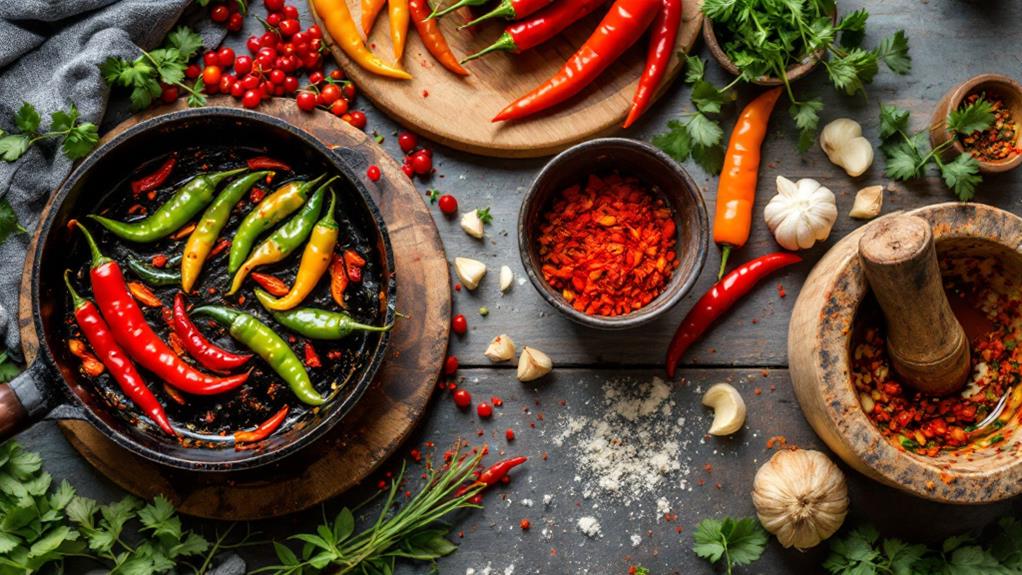
Peri-Peri peppers offer numerous culinary applications that can improve your cooking to new heights. These versatile chili peppers can be used fresh, dried, or ground, allowing you to experiment with a variety of flavors. Regardless of you're making a marinade for peri peri chicken or looking to spice up your grilled meats with a zesty sauce, Peri-Peri peppers have got you covered.
Add depth to your dishes with a homemade sauce that includes garlic and lemon juice, perfect for infusing a smoky flavor into your meals. You can also investigate by creating:
- Marinades: Mix Peri-Peri peppers with garlic and lemon juice to make a flavorful marinade for chicken or other meats.
- Infused Oils and Vinegars: Use the peppers to create dressings and dipping sauces that improve salads and appetizers.
- Modern Dishes: Incorporate Peri-Peri into chili con carne or gazpacho for a unique twist.
- Spice Blends: enhance your spice rack with a customized blend including these fiery peppers.
Peri-Peri peppers' unique taste profile brings out the best in grilled meats, seafood, and even vegetarian dishes, showcasing their adaptability across global cuisines.
Popular Peri-Peri Dishes
Many have uncovered the joy of indulging in popular Peri-Peri dishes, known for their bold flavors and tantalizing heat. At the forefront is the iconic Peri-Peri Chicken, marinated in a zesty blend of peri-peri sauce, garlic, and lemon juice. This southern African delight, hailing from Mozambique and Angola, is often grilled to perfection. The grill imparts a crispy exterior while keeping the inside juicy, offering a smoky flavor that complements the spiciness of the marinade.
If you're craving seafood, Peri-Peri shrimp is another flavorful option. By combining peri-peri sauce with garlic and olive oil, you can create a mouth-watering marinade that raises the taste of the shrimp when grilled or sautéed. The dish embodies the perfect balance of heat and zest, making it a favorite among seafood lovers.
Beyond chicken and shrimp, peri-peri sauce is a flexible enhancement to numerous recipes. You can improve barbecued meats or create spicy kebabs that burst with flavor. Even a classic chili con carne can benefit from the unique kick of peri-peri. Remember, letting the marinade infuse for hours or overnight guarantees maximum flavor in your dishes.
Making Peri-Peri Sauce
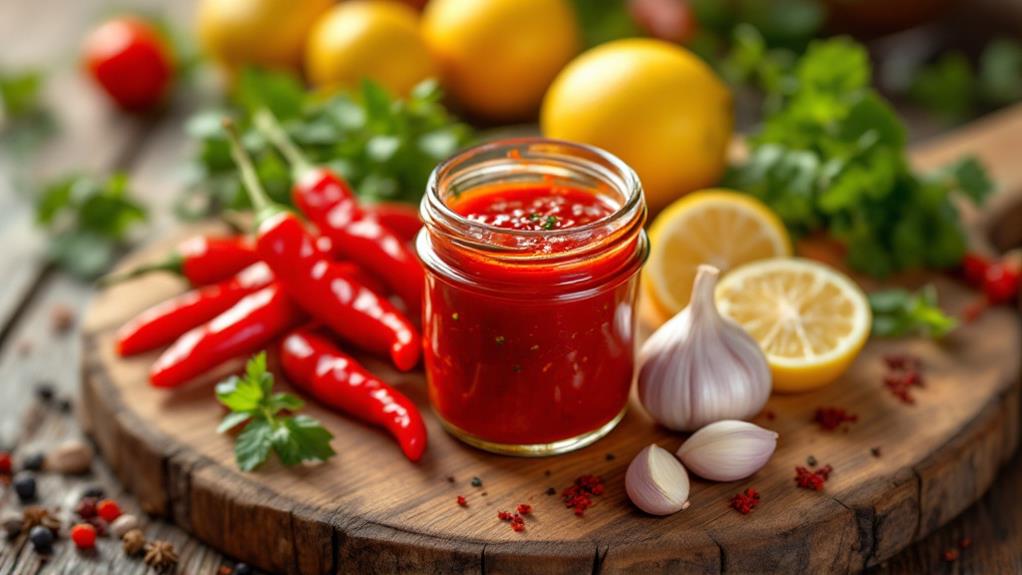
Indulging in popular Peri-Peri dishes is just the start; crafting your own peri-peri sauce can improve your culinary experience to new heights. Start by blending fresh peri-peri chili peppers, garlic, lemon juice, vinegar, and olive oil into a smooth paste. This combination promises an authentic flavor that's both lively and versatile. You can easily tailor the heat level by removing the seeds from the chili peppers for a milder sauce or keeping them if you prefer a spicier kick.
To take your peri-peri sauce up a notch, consider these tips:
- Roast red peppers and onions beforehand to add a smoky complexity.
- Allow the sauce to infuse in the refrigerator for several days to deepen its flavors.
- Use it as a marinade for meats or a zesty dipping sauce.
- Store it in an airtight container in the fridge for up to two weeks to preserve its taste.
Your homemade peri-peri sauce will be infused with flavors that raise any dish it touches. Regardless of you're using it as a marinade or serving it as a dipping sauce, you'll savor the invigorating blend of spices and heat.
Recipe: Peri-Peri Chicken
Submerge yourself in the bold flavors of Southern Africa with a tantalizing recipe for Peri-Peri Chicken. To start, you'll need to marinate your chicken in a lively peri-peri sauce. This sauce is a delightful mix of chili peppers, garlic, lemon juice, and herbs, giving the chicken a spicy and tangy flavor profile that's hard to resist. Originating from Mozambique and Angola, Peri-Peri Chicken has become a staple, celebrated for its intense taste and cultural roots.
Begin by preparing your marinade. Combine the peri-peri sauce ingredients, adjusting the amount of chili peppers based on your heat preference. Remember, these peppers can range from 50,000 to 175,000 Scoville Heat Units, so choose wisely to suit your palate. Once your marinade is ready, let the chicken soak in it for several hours or, better yet, overnight. This guarantees the flavors deeply penetrate the meat.
When it's time to cook, fire up the grill. Grilling will give your Peri-Peri Chicken a crispy exterior while keeping the inside juicy. This versatile dish pairs beautifully with rice, salad, or grilled vegetables, making it perfect for any dining occasion. Enjoy the spicy adventure!
Variations and Names
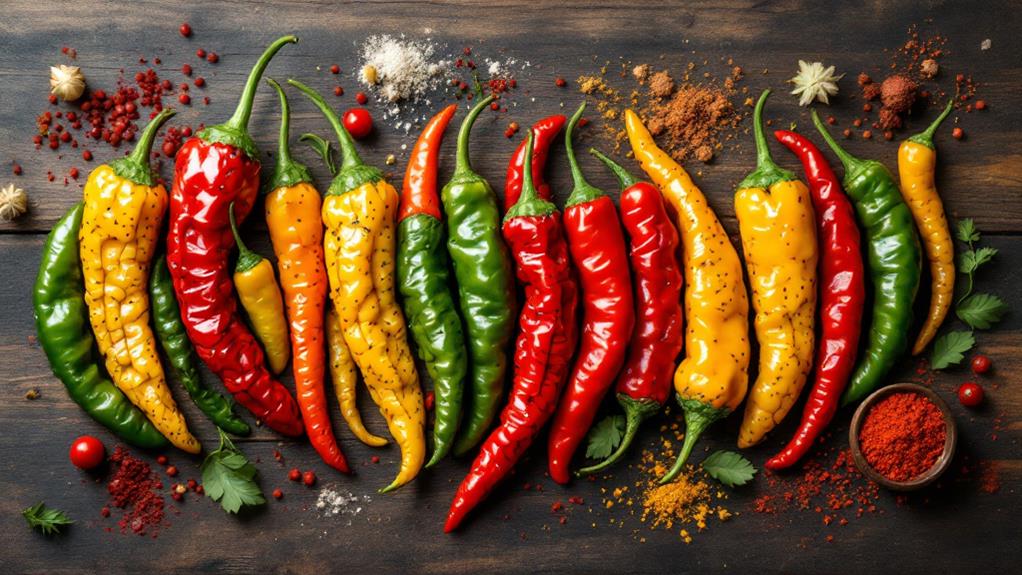
Across different regions, the Peri-Peri pepper is celebrated under different names, reflecting its rich cultural voyage. Each name tells a story of the pepper's path through numerous culinary traditions across Africa and beyond. In Mozambique and Portugal, you'll hear it called "Piri-Piri", a name that hails from the Swahili word for chili, underlining its deep African roots. In Tanzania, Kenya, and Reunion, it's known as "Pilipili", while in South Africa and Malawi, the spelling "Peri Peri" is more common. Madagascar offers its own variation with "pily kely".
These variations aren't just about phonetics; they're about culture and geography. Despite the differences, all these names refer to the same fiery variety of Capsicum Frutescens, renowned for its heat and flavor. Welcomed by different regions, the pepper's nomenclature highlights its widespread influence.
- Pilipili: Used in Tanzanian, Kenyan, and Reunionese cuisines.
- Piri-Piri: Popular in Mozambique and Portugal.
- Peri Peri: Common spelling in South Africa and Malawi.
- Pily Kely: Found in Madagascar.
Experience the lively world of Peri-Peri and connect with its global yet distinctly African path.
Global Influence
Peri-Peri peppers, with their myriad of names, have not only marked their presence across Africa but have also made a significant impact on global cuisine. Originating in Southeastern Africa, these chilies soared to popularity when Portuguese settlers in Mozambique introduced them to Europe in the 15th century. The name "peri-peri" is derived from the Swahili word for chili, demonstrating its rich African heritage. Known as "piri-piri" in Mozambique and Portugal, these peppers have become a cornerstone of Portuguese culinary traditions.
The famed peri-peri sauce, crafted from these fiery peppers, has gained a global following. It's a staple in grilled dishes, adding a unique flavor that captivates taste buds worldwide. Iconic establishments like Nando's have championed this sauce, spreading its popularity from the UK to other parts of the world. But the influence doesn't stop there. Peri-peri has infiltrated the culinary scenes of India, Southeast Asia, and the Americas, proving its adaptability across diverse cuisines.
Chefs and home cooks alike welcome the distinct heat and flavor of peri-peri peppers, inspiring countless adaptations of the original sauce and enriching global culinary practices.

